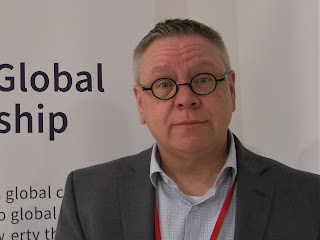The first
thing that will strike pedestrians this month as they approach the Maison de l’Amérique
Latine in Paris is the riot of colour – vivid reds, yellows and blues on a
massive banner announcing a special kind of party.
 |
| One of the posters for the exhibition. |
Until May 7,
the Maison (or MAL) is hosting Fiesta
Gráfica, an exhibition of pulsating graphic artwork by French artist and
curator Michel Bouvet and his 26 “friends” who hail from nine Latin American
countries.
The show is the fruit of Bouvet’s travels throughout
Latin America and of the collaborations and friendships he has formed over the
past 30 years. The wide-ranging exhibition includes political posters, graphic
novels, cartoons, advertisements and other forms of graphic art, and it
highlights a variety of techniques and perspectives, across decades and
borders.
Bouvet’s own
designs are regularly visible in the Paris Metro and on the city’s Colonnes Morris, announcing La Fête de la Musique or Les Rencontres d’Arles, and he has been
a fixture in French graphic art since the 1970’s.
 |
| An art fan views works by Cuba's Idania del Rio. |
Alongside some
of his most well-known affiches, Fiesta Gráfica offers works of diverse artists, 11 of whom work in
collectives.
The countries represented include Argentina, Brazil, Colombia, Cuba,
Ecuador, Mexico and Paraguay, and the artwork provides commentary on social and
philosophical issues, among other themes. A notable feature is the presence of
many women artists (so often missing from group exhibitions), with striking works
by Bebel Abreu of Brazil, Idania del Rio of Cuba, and Marta Granados of
Colombia, for example.
As visitors
enter the lobby of MAL’s imposing building, they are first greeted by a joyous
poster of bold lines and the words “FRIDA & DIEGO” against a yellow
background. Meanwhile, the rooms on either side of the lobby are filled with
giant-sized works by Bouvet, “in dialogue” with works by artists from a range of
countries.
Crowds packed
these rooms on a recent Saturday, among them Paris-based artist Randy Dims who
gazed intently at each poster, as if absorbing their energy.
 |
| Paris-based artist Randy Dims at the exhibition. |
The
exhibition fills the vast downstairs spaces of the MAL as well. Here, the
collage pieces of the collective El
Fantasma de Heredia (Argentina), the satirical images of Bebel Abreu
(Brazil) and the lyrical, surreal compositions of Celeste Prieto (Paraguay) comprise
just a small sampling of the dozens of works by the effervescent community of
graphic artists active in Latin America.
Socially
engaged and provocative, these artists believe, as the Uruguay militant Pablo
Irturralde puts it, that “the poster is a poem”, and a weapon in the fight
against injustice. This show is a visual fiesta of colour and content and well
worth the visit. – Susan Hamlin / SWAN
FIESTA
GRAFICA, MAISON DE L’AMÉRIQUE LATINE, PARIS. More information: www.mal217.org





